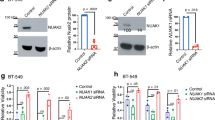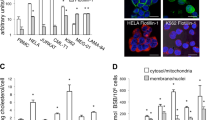Abstract
Protein kinase casein kinase II (CK2) is increased in response to diverse growth stimuli, as well as being elevated in many human cancers examined. We have demonstrated that CK2 is a key survival factor that protects human colon carcinoma cells from TNF-related apoptosis-inducing ligand (TRAIL)-induced apoptosis. We determined that inhibition of CK2 phosphorylation events by DRB (5,6-dichlorobenzimidazole) resulted in dramatic sensitization of tumor cells to TRAIL-induced apoptosis, in the absence of effects in normal cells. Sensitization was caspase dependent, and independent of regulation via NF-κB. Further, inhibition of phosphorylation by CK2 did not modify the expression level of antiapoptotic proteins. Analysis of TRAIL-induced death-inducing signaling complex (DISC) formation demonstrated enhanced formation of the DISC, enhanced cleavage of caspase-8 and cleavage of Bid in the presence of DRB, thereby facilitating the release of proapoptotic factors from the mitochondria with subsequent downregulation of the expression of XIAP and c-IAP1. Further, silencing of CK2α in HT29 cells following transfection of CK2α shRNA abrogated CK2 kinase activity while simultaneously increasing TRAIL sensitivity. These findings demonstrate that CK2 plays a critical antiapoptotic role by conferring resistance to TRAIL at the level of the DISC.
This is a preview of subscription content, access via your institution
Access options
Subscribe to this journal
Receive 50 print issues and online access
$259.00 per year
only $5.18 per issue
Buy this article
- Purchase on Springer Link
- Instant access to full article PDF
Prices may be subject to local taxes which are calculated during checkout








Similar content being viewed by others
Abbreviations
- CK2:
-
casein kinase II
- TRAIL:
-
TNF-related apoptosis-inducing ligand
- GFP:
-
green fluorescence protein
- DISC:
-
death-inducing signaling complex
- DRB:
-
5,6-dichlorobenzimidazole
- IAP:
-
inhibitor of apoptosis protein
- shRNA:
-
short hairpin RNA
References
Allende JE and Allende CC . (1995). FASEB J., 9, 313–323.
Almasan A and Ashkenazi A . (2003). Cytokine Growth Factor Rev., 14, 337–348.
Ashkenazi A, Pai RC, Fong S, Leung S, Lawrence DA, Marsters SA, Blackie C, Chang L, McMurtrey AE, Hebert A, DeForge L, Koumenis IL, Lewis D, Harris L, Bussiere J, Koeppen H, Shahrokh Z and Schwall RH . (1999). J. Clin. Invest., 104, 155–162.
Beg AA, Sha WC, Bronson RT and Baltimore D . (1995). Genes Dev., 9, 2736–2746.
Bernard D, Quatannens B, Vandenbunder B and Abbadie C . (2001). J. Biol. Chem., 276, 27322–27328.
Desagher S, Osen-Sand A, Montessuit S, Magnenat E, Vilbois F, Hochmann A, Journot L, Antonsson B and Martinou JC . (2001). Mol. Cell, 8, 601–611.
Ehrhardt H, Fulda S, Schmid I, Hiscott J, Debatin KM and Jeremias I . (2003). Oncogene, 22, 3842–3852.
Faust RA, Niehans G, Gapany M, Hoistad D, Knapp D, Cherwitz D, Davis A, Adams GL and Ahmed K . (1999). Int. J. Biochem. Cell Biol., 31, 941–949.
Griffith TS, Chin WA, Jackson GC, Lynch DH and Kubin MZ . (1998). J. Immunol., 161, 2833–2840.
Griffith TS and Lynch DH . (1998). Curr. Opin. Immunol., 10, 559–563.
Guo C, Yu S, Davis AT, Wang H, Green JE and Ahmed K . (2001). J. Biol. Chem., 276, 5992–5999.
Hofmann K, Bucher P and Tschopp J . (1997). Trends Biochem. Sci., 22, 155–156.
Holmstrom TH and Eriksson JE . (2000). Crit. Rev. Immunol., 20, 121–152.
Holmstrom TH, Schmitz I, Soderstrom TS, Poukkula M, Johnson VL, Chow SC, Krammer PH and Eriksson JE . (2000). EMBO J., 19, 5418–5428.
Jeremias I and Debatin KM . (1998). Eur. Cytokine Network, 9, 687–688.
Keane MM, Rubinstein Y, Cuello M, Ettenberg SA, Banerjee P, Nau MM and Lipkowitz S . (2000). Breast Cancer Res. Treat., 64, 211–219.
Kikkawa U, Mann SK, Firtel RA and Hunter T . (1992). Mol. Cell. Biol., 12, 5711–5723.
Krippner-Heidenreich A, Talanian RV, Sekul R, Kraft R, Thole H, Ottleben H and Luscher B . (2001). Biochem. J., 358, 705–715.
Lacour S, Micheau O, Hammann A, Drouineaud V, Tschopp J, Solary E and Dimanche-Boitrel MT . (2003). Oncogene, 22, 1807–1816.
Landesman-Bollag E, Romieu-Mourez R, Song DH, Sonenshein GE, Cardiff RD and Seldin DC . (2001). Oncogene, 20, 3247–3257.
Lee KA, Bindereif A and Green MR . (1988). Gene Anal. Tech., 5, 22–31.
Marsters SA, Pitti RM, Donahue CJ, Ruppert S, Bauer KD and Ashkenazi A . (1996). Curr. Biol., 6, 750–752.
McElhinny JA, Trushin SA, Bren GD, Chester N and Paya CV . (1996). Mol. Cell. Biol., 16, 899–906.
Munstermann U, Fritz G, Seitz G, Lu YP, Schneider HR and Issinger OG . (1990). Eur. J. Biochem., 189, 251–257.
Padmanabha R, Chen-Wu JL, Hanna DE and Glover CV . (1990). Mol. Cell. Biol., 10, 4089–4099.
Persons DA, Allay JA, Allay ER, Ashmun RA, Orlic D, Jane SM, Cunningham JM and Nienhuis AW . (1999). Blood, 93, 488–499.
Petak I, Vernes R, Szucs KS, Anozie M, Izeradjene K, Douglas L, Tillman DM, Phillips DC and Houghton JA . (2003). Cell Death Differ., 10, 729–739.
Ravi R and Bedi A . (2002). Cancer Res., 62, 4180–4185.
Romieu-Mourez R, Landesman-Bollag E, Seldin DC and Sonenshein GE . (2002). Cancer Res., 62, 6770–6778.
Ruzzene M, Penzo D and Pinna LA . (2002). Biochem. J., 364, 41–47.
Sarker M, Ruiz-Ruiz C and Lopez-Rivas A . (2001). Cell Death Differ., 8, 172–181.
Sarker M, Ruiz-Ruiz C, Robledo G and Lopez-Rivas A . (2002). Oncogene, 21, 4323–4327.
Scaffidi C, Fulda S, Srinivasan A, Friesen C, Li F, Tomaselli KJ, Debatin KM, Krammer PH and Peter ME . (1998). EMBO J., 17, 1675–1687.
Scaffidi C, Schmitz I, Zha J, Korsmeyer SJ, Krammer PH and Peter ME . (1999). J. Biol. Chem., 274, 22532–22538.
Schneider P, Thome M, Burns K, Bodmer JL, Hofmann K, Kataoka T, Holler N and Tschopp J . (1997). Immunity, 7, 831–836.
Sun XM, Bratton SB, Butterworth M, MacFarlane M and Cohen GM . (2002). J. Biol. Chem., 277, 11345–11351.
Tillman DM, Harwood FG, Gibson AA and Houghton JA . (1998). Cell Death Differ., 5, 450–457.
Trauzold A, Wermann H, Arlt A, Schutze S, Schafer H, Oestern S, Roder C, Ungefroren H, Lampe E, Heinrich M, Walczak H and Kalthoff H . (2001). Oncogene, 20, 4258–4269.
Varadhachary AS, Edidin M, Hanlon AM, Peter ME, Krammer PH and Salgame P . (2001). J. Immunol., 166, 6564–6569.
Wajant H, Johannes FJ, Haas E, Siemienski K, Schwenzer R, Schubert G, Weiss T, Grell M and Scheurich P . (1998). Curr. Biol., 8, 113–116.
Wang D, Westerheide SD, Hanson JL and Baldwin Jr AS . (2000). J. Biol. Chem., 275, 32592–32597.
Wang H, Davis A, Yu S and Ahmed K . (2001). Mol. Cell. Biochem., 227, 167–174.
Xu X, Toselli PA, Russell LD and Seldin DC . (1999). Nat. Genet., 23, 118–121.
Acknowledgements
This research was supported by NIH Awards CA 32613, Cancer Center Support (CORE) Grant CA 21765 and by the American Lebanese Syrian Associated Charities.
Author information
Authors and Affiliations
Corresponding author
Rights and permissions
About this article
Cite this article
Izeradjene, K., Douglas, L., Delaney, A. et al. Casein kinase II (CK2) enhances death-inducing signaling complex (DISC) activity in TRAIL-induced apoptosis in human colon carcinoma cell lines. Oncogene 24, 2050–2058 (2005). https://doi.org/10.1038/sj.onc.1208397
Received:
Revised:
Accepted:
Published:
Issue Date:
DOI: https://doi.org/10.1038/sj.onc.1208397
Keywords
This article is cited by
-
Protein kinase CK2 – diverse roles in cancer cell biology and therapeutic promise
Molecular and Cellular Biochemistry (2023)
-
Inhibition of CK2 mitigates Alzheimer’s tau pathology by preventing NR2B synaptic mislocalization
Acta Neuropathologica Communications (2022)
-
A mitophagy-related gene signature associated with prognosis and immune microenvironment in colorectal cancer
Scientific Reports (2022)
-
Disrupting CCT-β : β-tubulin selectively kills CCT-β overexpressed cancer cells through MAPKs activation
Cell Death & Disease (2017)
-
Targeting CK2-driven non-oncogene addiction in B-cell tumors
Oncogene (2016)



